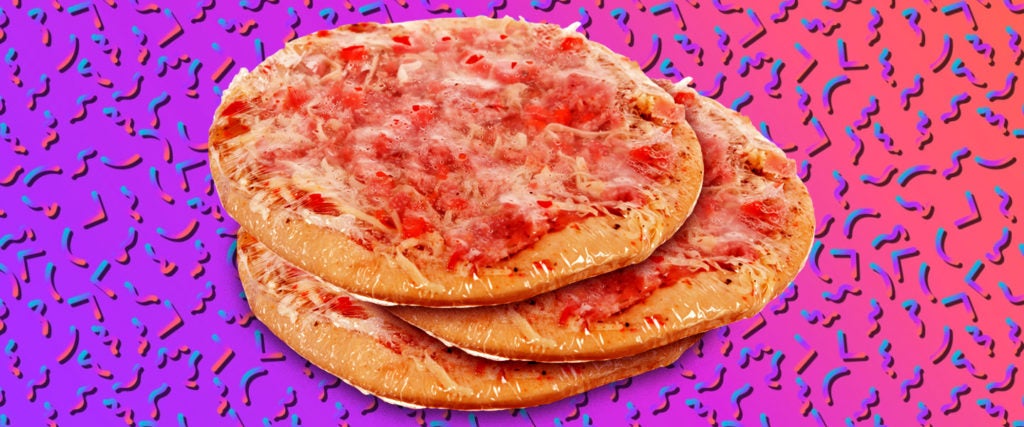During my formative years, my love affair with pizza had already begun. It was the late 1980s and early 1990s, and I was just a kid who didn’t know any better, so I was content to eat my cardboard-flavored Ellio’s pizza while jamming on my VHS tapes of the Teenage Mutant Ninja Turtles. However, in 1995, when I was just nine years old, a monumental change took place across the frozen pizza landscape that I failed to appreciate at the time. Thanks to the creation of DiGiorno and their rising crust, frozen pizza stopped being the crappy, tasteless pizza imitation that it had been for almost 50 years, suddenly becoming an almost acceptable alternative to actual freshly-made pizza.
Frozen pizza started becoming a thing in the late 1940s, but it was unrecognizable by modern standards. Instead of national brands selling frozen pizza in the supermarket, it was your local pizzeria selling an unbaked, frozen pie. Just popping it in the oven later was hardly satisfactory, as Invention & Technology explains, saying that “customers complained about soggy or crumbly dough and tasteless toppings.” The problem was the ice crystals that formed during freezing. These ice crystals would break down the gluten in the dough and destroy the cellular structure of the toppings. Pre-baking the crust became the solution to some of those problems, as it helped to preserve the structure of the pizza, but it still didn’t taste all that great.
Read next: Healthiest Pizza Toppings: Healthy Meat and Veggie Pizzas to Order
In the 1950s, frozen foods finally became mainstream and pizza was there to ride the wave alongside TV dinners. While local frozen pizza distributors predated them, the first nationally-marketed brand of frozen pizza was Celentano Brothers, followed by Totino’s, the latter of which is still around today. These brands — and the ones to follow in the next four decades — all precooked their dough to ensure their pizza was sturdy enough. But while frozen pizza never stopped being carried in the supermarket’s freezer aisle, it was never considered to be anything like the real thing.
The next few decades weren’t entirely without frozen pizza innovation. Pizza Rolls were invented in 1968, and Bagel Bites came out in 1985. Popular brands developed along the way, too, like Tombstone in 1962 and Red Baron in 1976. But frozen pizza still remained something less than — it was kids’ food for the children of busy parents.
In 1995, though, things changed — big time. As The New York Times explained back in 2004, “In strictly frozen-pizza terms, the year 1995 was every bit as momentous as 1066 or 1492. Before that date, frozen pizzas were a gourmand’s worst nightmare: Overly chewy crusts topped with bland sauce, rubbery cheese and meat specks tougher than jerky. Then came Kraft Foods’ first pie sold under the DiGiorno brand name, and the industry was reborn.”
The difference was the rising crust, which is something that we take for granted today, but in 1995, it was an unprecedented breakthrough in frozen pizza technology.
The effort began in 1994 at Kraft with a man named Arthur Reingold, who was trying to develop a frozen pizza that wasn’t just better than the competition, but that could actually rival pizzeria pizza. The idea seemed impossible, but when Reingold began discussing the idea with a guy named Frank Cole, things started to take shape. Cole was part of General Foods in the 1980s, a time when the company had patented some technology around the freezing of dough. Cole used that knowledge to develop a frozen pizza that wasn’t pre-baked. Cole — now head of Research and Development at Nestlé — explains, “Leveraging years of research experience in frozen dough technology, we were able to develop and deliver a frozen pizza that baked up fresh, for the first time, in the home oven.”
For a time, Kraft considered selling these new pizzas under its already-established Tombstone brand, but eventually they went with ‘DiGiorno’ to give it a more authentic-sounding Italian name. They also found a memorable advertising slogan in, “It’s not delivery, it’s DiGiorno.”
Soon, other pizza companies upped their game, like Freschetta — which got its own rising crust in 1997 — and the overall standard for frozen pizza rose along with those crusts. To reflect this, food writers across the country began to write thinkpieces encouraging people to reconsider frozen pizza: “Frozen Pizzas Deserve Respect,” “Frozen Pizza is a Standby” and “Frozen Pizzas Worth Another Chance” were just a few of the articles appearing across the country in the latter half of the 1990s as part of frozen pizza’s redemption campaign.
The effort, led by DiGiorno’s breakthrough, was nothing short of a frozen pizza revolution, as The New York Times wrote: “In the two years after DiGiorno’s debut, total annual frozen-pizza sales soared from $500 million, to $2.2 billion. And in 1998, DiGiorno became the best-selling brand of frozen pizza, a title it has not relinquished since.” Today, some 25 years after DiGiorno’s debut and 16 years after that New York Times piece, that remains true, as DiGiorno still far exceeds its closest rival.
In the years since, frozen pizza has continued to remain relevant by continuing to innovate. In 2018, a spike in frozen pizzas occurred thanks to more variety, including healthier and gluten-free options (which, considering how mind-bogglingly unhealthy a DiGiorno’s frozen pizza is, came as a relief). You might even recall talk early this year of a potential frozen pizza shortage thanks to booming sales (unfortunately, this seems to be literally the only disaster we actually did avert this year).
All of this can be directly traced back to that singular achievement that occurred in 1995. So the next time you pop a delicious frozen pizza into the oven, raise a glass to Mr. Frank Cole, bringer of the rising crust, for without him, frozen pizza might still be in the dark ages.

